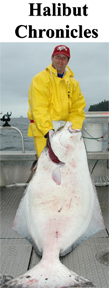Thursday night I sat in on the North of Falcon meeting held at the North Olympic Chapter of Puget Sound Anglers. Many issues were discussed but one really caught my attention — a size reduction for winter blackmouth from the current minimum size of 22 inches to 20 inches. Please read the handout from Washington Department of Fish & Wildlife. WDFW wants your comments and welcomes them on this subject. Please click here <<< after reading the fact sheet below and submit your thoughts and opinions. Remember, if you don’t speak out you will never be heard. My opinion will be below the fact sheet.
Puget Sound Chinook Winter Minimum Size Limit Reduction Fact Sheet
Background: The minimum size limit for Chinook retention has varied widely during the history of the Puget Sound sport fishery. It was 12 inches in the 1930’s, no size limit in the 1970’s, size limit of 20 inches in the late 1970’s and has remained 22 inches (today’s limit) since 1983. The current size limit (22 inches) was designed to help achieve 50:50 harvest sharing between state and tribal fisheries. The idea of reducing the size limit has been proposed by anglers for many years with options ranging from year-round size limit reductions to reductions only within winter blackmouth and/or mark-selective fisheries (MSF). The majority of the support is for winter MSF’s only.
1) Modeling of the size limit change has been approved
In 2013 the Pacific Fishery Management Council approved the changes necessary to properly model size limit changes in the Fishery Regulation Assessment Model (FRAM).
2) Size limit reductions will have a negligible impact on ESA-listed Chinook
Preliminary modeling indicates that reducing the minimum size limit from 22 inches to 20 inches during winter MSFs (Mark-Selective Fisheries) will not measurably increase ESA impacts, because these are mark-selective, hatchery-directed fisheries.
3) Recreational fisheries will see an increase in the number of allowable encounters
The abundance and size structure of fish present in the Puget Sound in any given year is variable, but on average reducing the size limit to 20 inches may translate into a 30% increase in what’s considered to be legal to keep during winter MSFs and a 10% increase during summer fisheries. These estimates are based on test fishery length-frequency data and correspond well with FRAM predictions.
4) Released fish have a very low chance of being caught again
The loss in future access to big Chinook (age 4-5) due to the increased harvest of small blackmouth (mostly age 2) is minimal due to the natural mortality that will occur anyway (e.g., 50% chance of surviving from age 2 to 5 in the absence of fishing and maturation), combined with the relatively small contribution to total fishery-related mortality arising from current fisheries. For these same reasons, it is unlikely that any increase in harvest of 20-22 inch fish during winter MSFs will cause an evolutionary change (e.g., toward younger maturation) in the targeted hatchery populations.
5) Monitoring fisheries will continue so that changes are well understood
Given that it has been nearly 20 years since the minimum limit was less than 22 inches, it will be necessary to monitor fisheries subject to this potential regulation change at a level that’s sufficient to measure changes in total fishing effort, angler behavior (e.g., compliance, voluntary release), catch success, and stock exploitation patterns. The sampling programs already in place for our intensively monitored mark-selective fisheries are sufficiently rigorous to provide this insight, but new approaches may also be considered.
6) Reasoning for reducing the size limit to 20 inches during winter fisheries
Reducing the minimum size limit to 20 inches will allow for more successful trips. It will allow anglers to access a greater fraction of the hatchery production that they help to fund through license fees, while simultaneously reducing the number of hatchery strays on spawning grounds. Increased harvest in non-treaty sport fisheries will help restore 50:50 sharing of allowable catch where inequities are perceived. End of WDFW draft 3/2/2015
Click Here <<< to submit your online comments regarding this and other possible changes in Washington State’s sport fishing rules and regulations.
My thoughts: Please note, this fact sheet clearly shows that recreational anglers are not reaching their 50 percent total harvest. In other words, the tribes have been catching more than 50 percent. This proposal will bring sports anglers back to a 50:50 split of the hatchery Chinook resource. Also note, many anglers in the winter blackmouth fishery, including me, release blackmouth measuring between 20 and 21.9 inches. Roughly 10 percent of these released fish will die according to WDFW statistics. This small total of the resource gets wasted while leaving many anglers with an empty fish box.
I think this proposal has merit and should be adopted. If passed into law, anglers who choose to release these smaller “legal sized” Chinook will now have that choice of keeping or releasing these fish.
Please make your opinions known and comment on the WDFW website.
Thanks,
John




